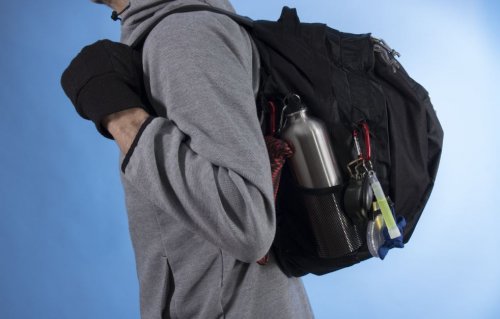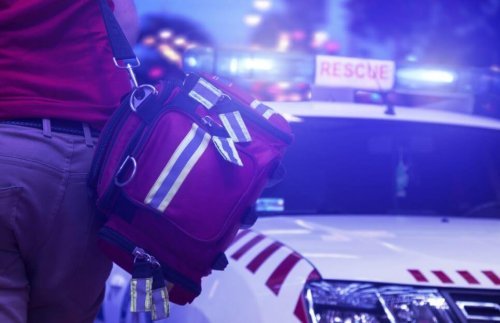Do You Know How to Prepare an Emergency Backpack?

Have you heard that governments around the world are recommending that we have an emergency backpack at the ready? Do you know why this is? We’re going to look at this in more detail and, most importantly, we’re going to teach you how to prepare yours.
What is an emergency backpack?
An emergency backpack is similar to a “pantry” full of useful items in case of a natural disaster. We can choose to ignore any advice and believe that nothing will happen where we live.
However, this is a mistake that may lead to many to many lives being lost in the face of a natural disaster. We must remember that in recent years, there’s been an increasing number of earthquakes, floods, typhoons, tidal waves, and tornadoes. More so than at any other time in mankind’s history.

This is mainly due to climate change and the damage caused to the ozone layer. We’re destroying the earth. Don’t forget that in Spain, one of the strongest earthquakes that had ever existed took place. This caused many people in the town of Lorca to lose their homes and their lives.
Later, other earthquakes in Malaga, Almeria, and Granada occurred. Also, heavy floods caused many to lose their homes, and snowstorms left thousands of people trapped for days.
Due to all of these events, governments now strongly recommend that we have an emergency backpack at home for each member of our family. In the case that we were involved in a disaster, this could maintain us or even save our lives, until rescue arrives.
How should an emergency backpack be prepared and what should it contain?
The emergency backpack should be similar to the kinds of backpack that are used for hiking. It needs to be big enough to carry everything listed below, and also made of resistant materials that are capable of withstanding any weather.

It’s best to choose an impermeable backpack because it will allow us to keep everything in good condition. Especially if we have to swim or wade through water. Depending on how many people live in a household, the backpack, or backpacks, should be stored in an accessible area. This way, we can quickly locate it, without having to stop and search for it.
Here’s what your emergency backpack should contain:
- Blankets: preferably thermal (since they are effective and take up little space), a complete change of warm clothes, and sturdy shoes.
- A flashlight, radio (battery or crank), and spare batteries.
- A first aid kit and a whistle to call for help.
- Cutlery: a can opener, a multipurpose pocket tool, and waterproof matches.
- Masks, waterproof adhesive tape, and plastic tarpaulin for covering.
- Toothbrushes, soap, wipes, and toilet paper. A towel can also be useful.
- Items and medication used for taking care of children and people who are old or sick.
- A waterproof container with copies of medical prescriptions, and important documents.
- The phone numbers of your contacts, meeting places, and a map of the area.
- Credit cards and cash.
- An extra set of house keys and car keys.
- Canned food with long expiration dates or non-perishable food, such as nuts, energy bars, etc. It’s best to have caloric food that can maintain us with less quantity.
- Water for at least three days. We recommend between 1.5 liters and 3 liters per person. Everything will also depend on how much you can carry.
- An extra mobile phone with a charged battery.
- External mobile phone charger or a sheet of solar panels.
- Water purification pills or a filter for use in its absence. In case the water supply is depleted, this will serve to clean dirty water, even from puddles.
Start preparing your emergency backpack today. You may never have to use it, but it’s better to be cautious. Remember to check the food and water every year and change them if necessary.
Have you heard that governments around the world are recommending that we have an emergency backpack at the ready? Do you know why this is? We’re going to look at this in more detail and, most importantly, we’re going to teach you how to prepare yours.
What is an emergency backpack?
An emergency backpack is similar to a “pantry” full of useful items in case of a natural disaster. We can choose to ignore any advice and believe that nothing will happen where we live.
However, this is a mistake that may lead to many to many lives being lost in the face of a natural disaster. We must remember that in recent years, there’s been an increasing number of earthquakes, floods, typhoons, tidal waves, and tornadoes. More so than at any other time in mankind’s history.

This is mainly due to climate change and the damage caused to the ozone layer. We’re destroying the earth. Don’t forget that in Spain, one of the strongest earthquakes that had ever existed took place. This caused many people in the town of Lorca to lose their homes and their lives.
Later, other earthquakes in Malaga, Almeria, and Granada occurred. Also, heavy floods caused many to lose their homes, and snowstorms left thousands of people trapped for days.
Due to all of these events, governments now strongly recommend that we have an emergency backpack at home for each member of our family. In the case that we were involved in a disaster, this could maintain us or even save our lives, until rescue arrives.
How should an emergency backpack be prepared and what should it contain?
The emergency backpack should be similar to the kinds of backpack that are used for hiking. It needs to be big enough to carry everything listed below, and also made of resistant materials that are capable of withstanding any weather.

It’s best to choose an impermeable backpack because it will allow us to keep everything in good condition. Especially if we have to swim or wade through water. Depending on how many people live in a household, the backpack, or backpacks, should be stored in an accessible area. This way, we can quickly locate it, without having to stop and search for it.
Here’s what your emergency backpack should contain:
- Blankets: preferably thermal (since they are effective and take up little space), a complete change of warm clothes, and sturdy shoes.
- A flashlight, radio (battery or crank), and spare batteries.
- A first aid kit and a whistle to call for help.
- Cutlery: a can opener, a multipurpose pocket tool, and waterproof matches.
- Masks, waterproof adhesive tape, and plastic tarpaulin for covering.
- Toothbrushes, soap, wipes, and toilet paper. A towel can also be useful.
- Items and medication used for taking care of children and people who are old or sick.
- A waterproof container with copies of medical prescriptions, and important documents.
- The phone numbers of your contacts, meeting places, and a map of the area.
- Credit cards and cash.
- An extra set of house keys and car keys.
- Canned food with long expiration dates or non-perishable food, such as nuts, energy bars, etc. It’s best to have caloric food that can maintain us with less quantity.
- Water for at least three days. We recommend between 1.5 liters and 3 liters per person. Everything will also depend on how much you can carry.
- An extra mobile phone with a charged battery.
- External mobile phone charger or a sheet of solar panels.
- Water purification pills or a filter for use in its absence. In case the water supply is depleted, this will serve to clean dirty water, even from puddles.
Start preparing your emergency backpack today. You may never have to use it, but it’s better to be cautious. Remember to check the food and water every year and change them if necessary.
This text is provided for informational purposes only and does not replace consultation with a professional. If in doubt, consult your specialist.








